I was interested in the first sown hectares and the first experience with this carried sowing machine, but also in the rest of the machine park, which is in our blue color. Mr. Ing. Miloš Bulíř provided me with his time and answered my questions. Miloš Bulíř, the company's director, was joined by his son, Miloš Bulíř as a technician. Unfortunately, for security reasons, the beginning and end of the conversation had to be done without a friendly handshake, but we did not do without veils and large distances between us.
Where are you, in which area is your farm and what do you focus on?
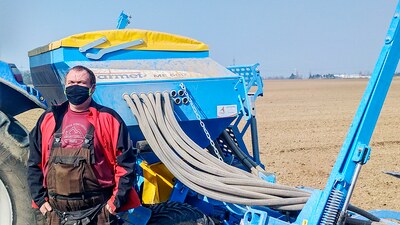 We operate in the Prague area. Most of our land, approximately 700 ha of arable land, is located in the Prague-East district. A small part of our land, less than 150 ha, is located in the municipalities of Újezd nad Lesy, Uhříněves and Škvorec. We grow cereals on these far land, so that we do not have to travel through Prague with great agricultural equipment. We grow about 400 ha of winter wheat and winter barley, 200 ha of lucerne, 150 ha of silage and 70 ha of grain corn. Our market crops include approximately 50 ha of malting barley. Crop production is strictly subordinate to animal production. From what we harvest, we "drive" through cattle, over cows and pigs. Our main focus is on the breeding of dairy cattle with a daily production of about 12 thousand liters of milk and we also marginally breed pigs with an approximate capacity of two thousand pieces, including sows. In our conditions, this represents 80 to 85% of all sales.
We operate in the Prague area. Most of our land, approximately 700 ha of arable land, is located in the Prague-East district. A small part of our land, less than 150 ha, is located in the municipalities of Újezd nad Lesy, Uhříněves and Škvorec. We grow cereals on these far land, so that we do not have to travel through Prague with great agricultural equipment. We grow about 400 ha of winter wheat and winter barley, 200 ha of lucerne, 150 ha of silage and 70 ha of grain corn. Our market crops include approximately 50 ha of malting barley. Crop production is strictly subordinate to animal production. From what we harvest, we "drive" through cattle, over cows and pigs. Our main focus is on the breeding of dairy cattle with a daily production of about 12 thousand liters of milk and we also marginally breed pigs with an approximate capacity of two thousand pieces, including sows. In our conditions, this represents 80 to 85% of all sales.
What technology do you use to grow crops?
As needed and according to what the current situation in the field requires. We are equipped for conventional technology and also for minimization processing. We use both conventional plows and, more recently, the increasingly popular chisel cultivators (plowing) and deep cultivators. When it comes to sowing winters, we usually go the minimization path. Mainly, because we would not be able to do everything in time with the classic preparation (plowing+Kompaktomat) but also because we are in the rain shadow. If we only used plowing, the soil would dry out very quickly and we could have problems with soil moisture, which would be reflected mainly in emergence. We mainly plow for crops we sow in the spring (corn, lucerne and malting barley).
Basic equipment has been supplied by Farmet. Can you please tell us which machines do you have and tell us your practical experience?
 The latest addition is the Monsun ME 600 sowing machine. We have only been using this sowing machine for a few days, but from what we have seen in the field and as the machine operator has told us, it is a very good and high-quality machine that has met our requirements and expectations.
The latest addition is the Monsun ME 600 sowing machine. We have only been using this sowing machine for a few days, but from what we have seen in the field and as the machine operator has told us, it is a very good and high-quality machine that has met our requirements and expectations.
What requirements did you have when choosing a sowing machine?
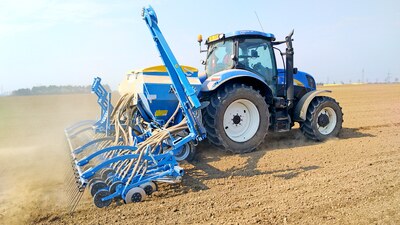 We were looking for a powerful sowing machine with a working width of 6 meters. Important for us was for example: simple operation, processing quality but also compactness. Therefore, the choice fell on the carried variant of the sowing machine. Our fields are not large and we need a machine which is easy to handle. Another benefit was also confirmed by the operator of the sowing machine, the tractor driver Jiří Husák who lived with the machine without any problems. After a quick training, he immediately began to intuitively control and adjust the machine. And he appreciates that all the adjusting elements are mechanical, easily accessible and easily adjustable. Another significant advantage for us is that, thanks to a simple readjustment for sowing small-seed grasses, we can sow approximately 200 ha of lucerne without any problems and with high quality.
We were looking for a powerful sowing machine with a working width of 6 meters. Important for us was for example: simple operation, processing quality but also compactness. Therefore, the choice fell on the carried variant of the sowing machine. Our fields are not large and we need a machine which is easy to handle. Another benefit was also confirmed by the operator of the sowing machine, the tractor driver Jiří Husák who lived with the machine without any problems. After a quick training, he immediately began to intuitively control and adjust the machine. And he appreciates that all the adjusting elements are mechanical, easily accessible and easily adjustable. Another significant advantage for us is that, thanks to a simple readjustment for sowing small-seed grasses, we can sow approximately 200 ha of lucerne without any problems and with high quality.
Another currently busy machine is the Kompaktomat. If I'm not mistaken, it has a range of 8 meters and you use it both now in spring and autumn in the above-mentioned minimization conditions. How does this machine work for you in a larger amount of post-harvest residues?
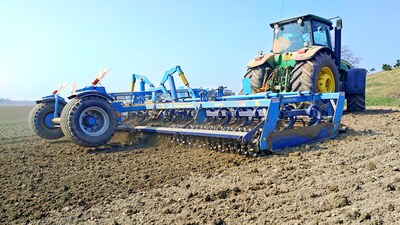 Yes, the Kompaktomat pre-sowing cultivator is a very busy machine used all year round. We don't have a problem with post-harvest residues after minimization, even if we use it after a Digger or Diskomat, for example. Even if we drive on corn, where there are usually the most post-harvest residues. I will just add that we usually mulch after corn. We don't have the classic arrow share on Kompaktomat, but we have the machine equipped with a chisel section. Thanks to this, a high clearance of the machine is ensured and even in the most difficult conditions, the machine doesn’t clog and works very well.
Yes, the Kompaktomat pre-sowing cultivator is a very busy machine used all year round. We don't have a problem with post-harvest residues after minimization, even if we use it after a Digger or Diskomat, for example. Even if we drive on corn, where there are usually the most post-harvest residues. I will just add that we usually mulch after corn. We don't have the classic arrow share on Kompaktomat, but we have the machine equipped with a chisel section. Thanks to this, a high clearance of the machine is ensured and even in the most difficult conditions, the machine doesn’t clog and works very well.
Other machines used by you are already directly intended for basic tillage. Did you mention at the beginning that you use a chisel cultivators? Did you mean the Digger deep cultivator, which could be used as an alternative to plowing?
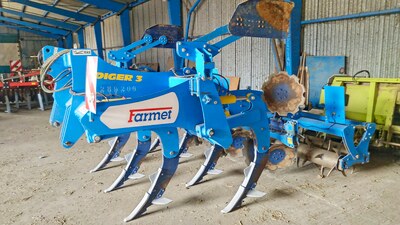 We use both conventional plows and your Digger deep cultivator. We are extremely satisfied with Digger. We use it both for basic cultivation and for autumn tillage before winter. Digger will find its use even after lucerne, the soils are very compacted and your machine can do them very well. I also would like to highlight that tillage with Digger is also economically useful for us. Wear parts last a lot of hectares, we also save on fuel and, most importantly, the efficiency is completely different from the plow. The procedure for lucerne is as follows: we spread manure, then we process it with Digger. In the spring, it is usually enough to use the Kompaktomat and sow the corn straight away. We don't sow after lucerne in the autumn, because, as I mentioned, there is usually rain shadow here and these fields are already very dry.
We use both conventional plows and your Digger deep cultivator. We are extremely satisfied with Digger. We use it both for basic cultivation and for autumn tillage before winter. Digger will find its use even after lucerne, the soils are very compacted and your machine can do them very well. I also would like to highlight that tillage with Digger is also economically useful for us. Wear parts last a lot of hectares, we also save on fuel and, most importantly, the efficiency is completely different from the plow. The procedure for lucerne is as follows: we spread manure, then we process it with Digger. In the spring, it is usually enough to use the Kompaktomat and sow the corn straight away. We don't sow after lucerne in the autumn, because, as I mentioned, there is usually rain shadow here and these fields are already very dry.
With such a large volume of animal production, do you have a sufficient amount of manure available? How do you processed manure? Which machine worked best for you?
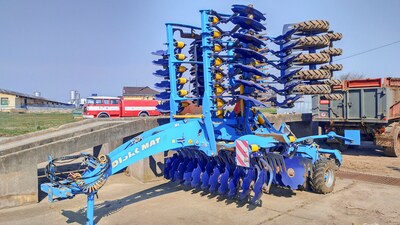 We also use Digger, as I mentioned in the previous answer, but mostly we process manure with Diskomat. We own a 6 meter disc cultivator with large discs and I guess a processing depth is up to 18 cm. It is a large, robust machine, has a strong oversized frame and large work discs that are very well sprung. We were most surprised by the large clearance and mixing effect of the machine. In our conditions, Diskomat is practically not possible to clog. We have tried several variants and methods for manure proccesing. It always depends on the current conditions. We throw the manure right on the stubble, then we process it with a Diskomat. Eventualy, we make the first stubble with Diskomat cultivator, then we will throw manure and process it again with Diskomat. In this way, we treat the manure before the next deep plowing or possibly before processing with Digger.
We also use Digger, as I mentioned in the previous answer, but mostly we process manure with Diskomat. We own a 6 meter disc cultivator with large discs and I guess a processing depth is up to 18 cm. It is a large, robust machine, has a strong oversized frame and large work discs that are very well sprung. We were most surprised by the large clearance and mixing effect of the machine. In our conditions, Diskomat is practically not possible to clog. We have tried several variants and methods for manure proccesing. It always depends on the current conditions. We throw the manure right on the stubble, then we process it with a Diskomat. Eventualy, we make the first stubble with Diskomat cultivator, then we will throw manure and process it again with Diskomat. In this way, we treat the manure before the next deep plowing or possibly before processing with Digger.
In conclusion, I would like to thank both gentlemen for a very pleasant morning and for the trust they have in the Farmet and our machines. I hope to see you again soon, for example when putting another purchased machine into operation.
Ing. Václav Mytyska
Technology and product consultant Farmet a. s.
